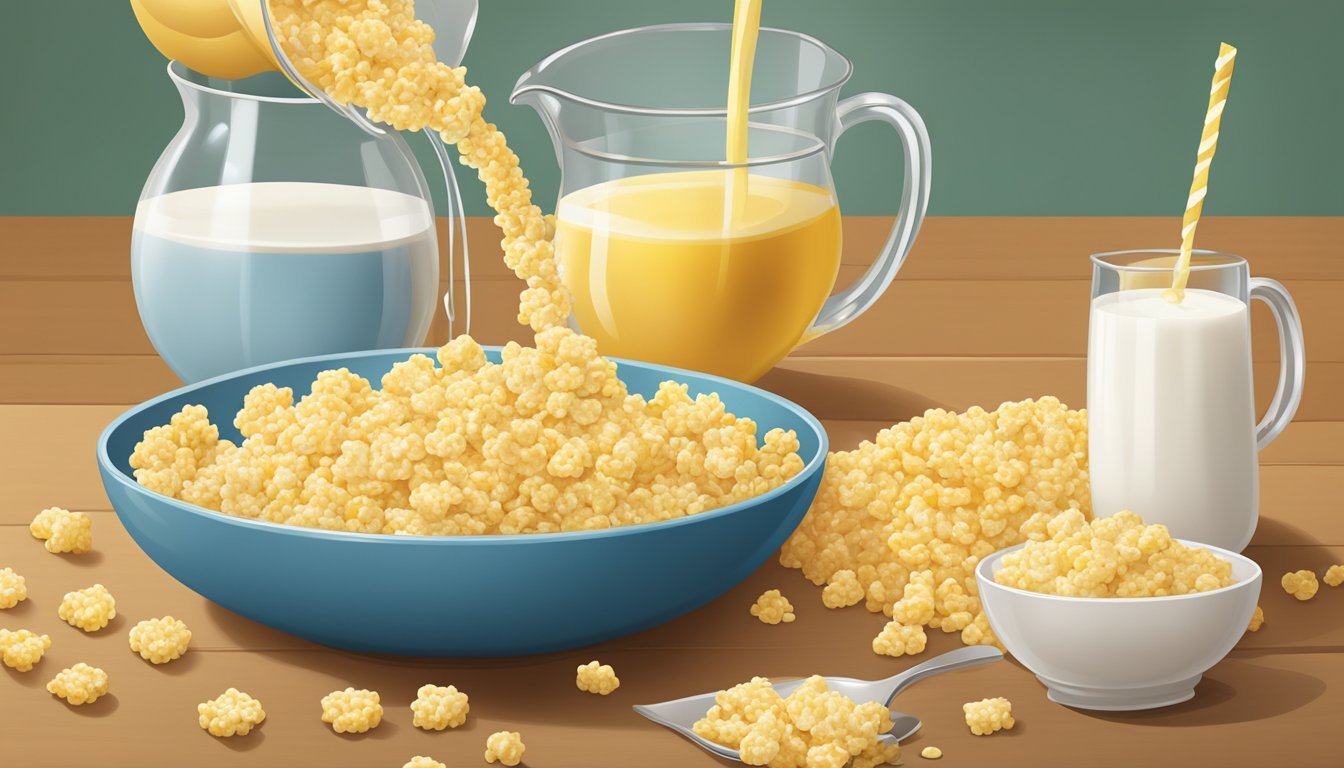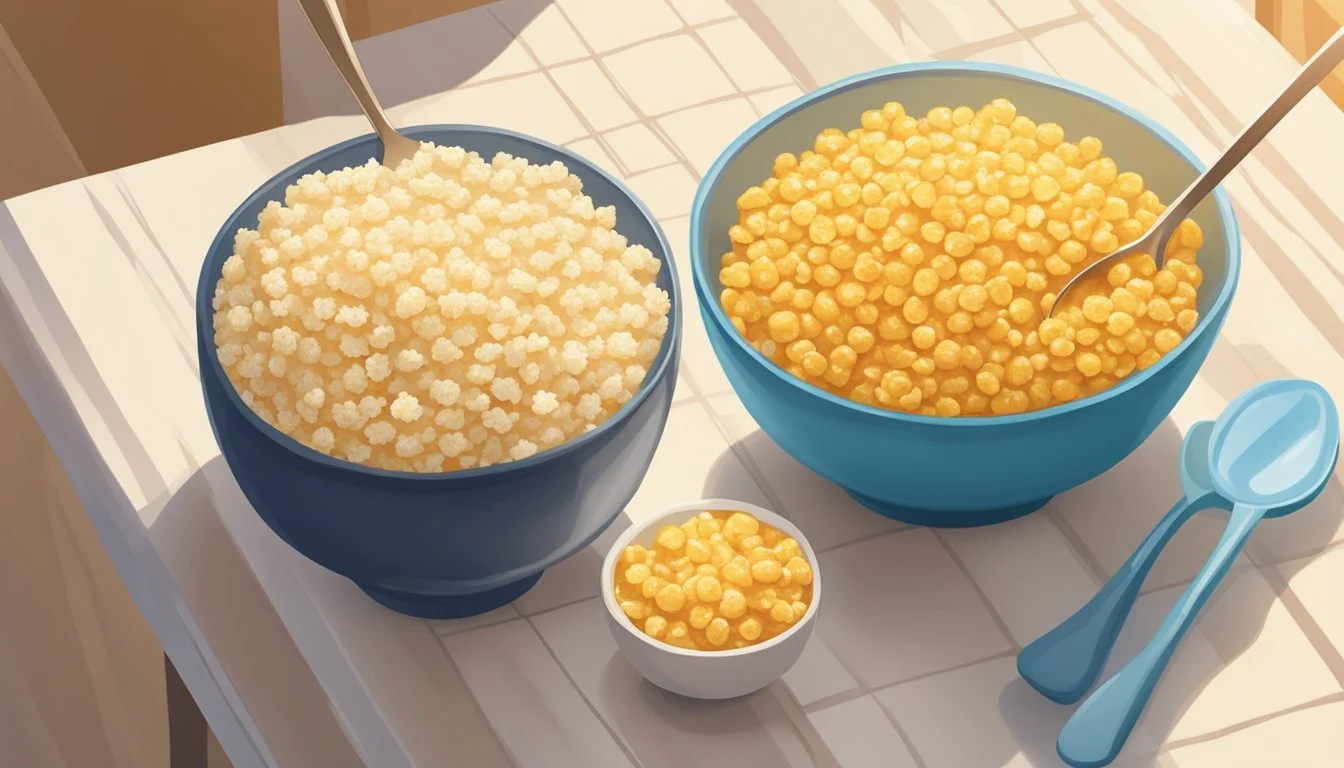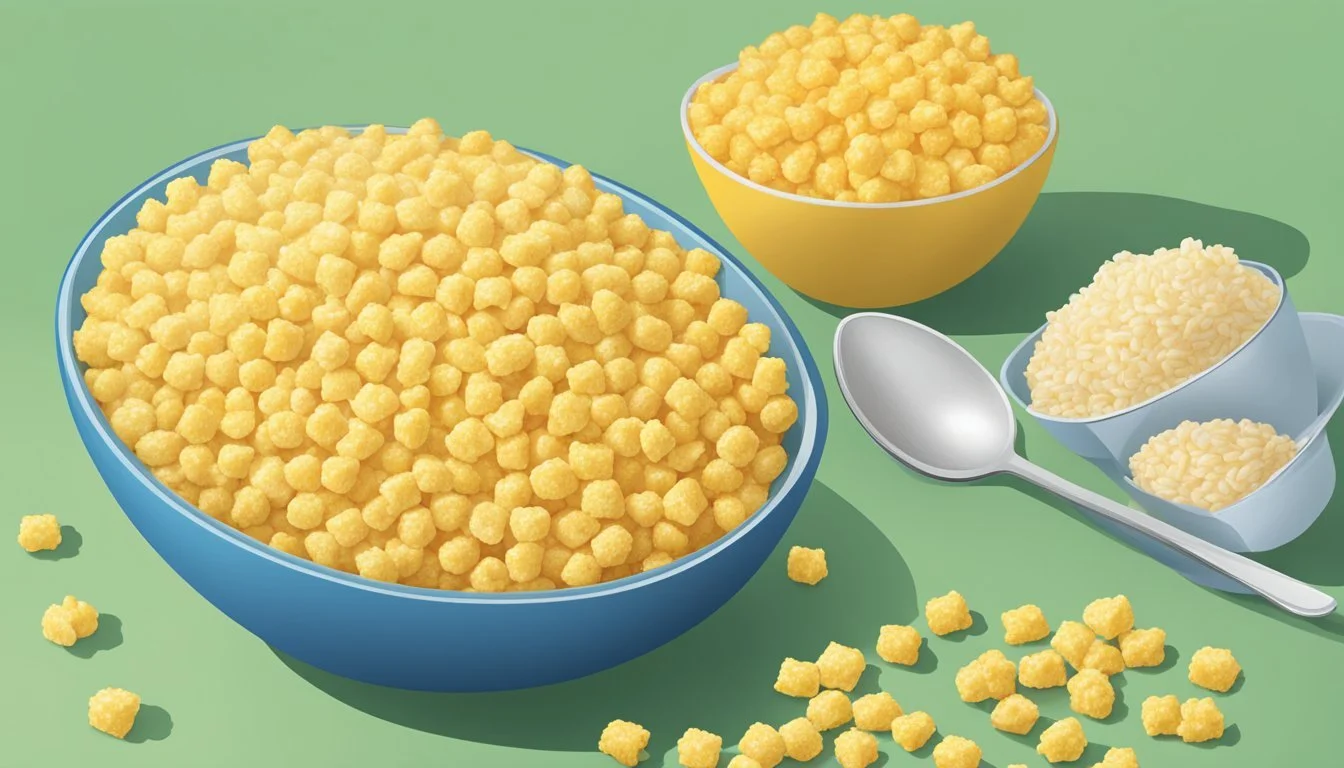Corn Pops vs Rice Krispies
Comparing Nutrition and Taste
This Article is Part of Our Breakfast Cereal Guide with Details on Corn Pops Nutrition and Rice Krispies Nutrition
When it comes to choosing between Corn Pops and Rice Krispies, both cereals offer distinct experiences and nutritional profiles. Kellogg's Corn Pops combine a crunchy, puffed corn texture with a sweet flavor, appealing particularly to those with a sweet tooth. They provide a quick, satisfying bite but come with a high sugar content that might make some health-conscious consumers hesitant.
In contrast, Rice Krispies have long been known for their simplicity and versatility. Comprising mainly of puffed rice, this cereal is lower in sugar and offers a lighter, more neutral taste. They are often favored by those looking to limit their sugar intake while still enjoying a crunchy breakfast option.
For those prioritizing a healthier choice, Rice Krispies generally come out ahead due to their lower sugar content. However, people seeking a more indulgent, sweet morning treat might lean towards Corn Pops. Each cereal brings its own benefits, creating a compelling reason to consider what you value most in your breakfast bowl.
Overview of Breakfast Cereals
Breakfast cereals have evolved significantly from their inception, catering to various dietary needs and preferences. Understanding their history and variety helps consumers make informed choices.
Historical Context
The concept of breakfast cereals dates back to the late 19th century. Dr. John Harvey Kellogg and Charles William Post were pioneers in this industry. They aimed to create healthy, easy-to-digest foods.
Corn flakes were among the first commercial cereals, introduced in 1906. They gained popularity due to their convenience and nutritional appeal.
By the mid-20th century, cereals like Rice Krispies and Cheerios emerged, offering different textures and flavors. The development of fortified cereals also aimed at addressing nutritional deficiencies by adding vitamins and minerals.
Types of Breakfast Cereals
Breakfast cereals today come in an array of options, categorized mainly into hot and cold cereals.
Hot cereals include options like oatmeal and shredded wheat. Oatmeal is rich in fiber and can be customized with fruits or nuts. Shredded wheat, usually made of whole grain, offers a hearty, fibrous option.
Cold cereals are more diverse. Varieties include Corn Flakes, Rice Krispies, and Cheerios, each with unique nutritional profiles. Corn flakes are lower in calories and fat, while Cheerios, made from whole grain oats, are favorable for heart health.
Honey Bunches of Oats and Raisin Bran provide combinations of grains, nuts, and fruits, appealing to those seeking a balance of taste and nutrition. Honey Bunches of Oats offer varied textures, and Raisin Bran adds sweetness from raisins combined with the benefits of bran.
This diverse range ensures that there’s a cereal suitable for everyone's taste and dietary requirements.
Comparative Analysis of Corn Pops and Rice Krispies
Corn Pops and Rice Krispies are two popular cereals with distinct nutritional profiles, main ingredients, and taste and texture.
Nutritional Profiles
Corn Pops
Calories per serving: Approximately 120
Total Fat: ~0.5 g
Sodium: ~95 mg
Carbohydrates: 26 g (13 g sugars, ~1 g fiber)
Protein: 1 g
Rice Krispies
Calories per serving: Approximately 130
Total Fat: 0 g
Sodium: ~290 mg
Carbohydrates: 29 g (4 g sugars, ~1 g fiber)
Protein: 2 g
Rice Krispies is slightly higher in calories and sodium compared to Corn Pops. Corn Pops has more sugar content. Protein levels are higher in Rice Krispies.
Main Ingredients
Corn Pops
Primary Ingredients: Milled corn, sugar, corn syrup, molasses
Additional Components: Salt, hydrogenated oils, color additives
Rice Krispies
Primary Ingredients: Milled rice, sugar, salt, malt flavor
Additional Components: Vitamins and minerals such as iron, niacinamide, and folic acid
Corn Pops primarily uses corn derivatives and has a higher sugar composition. Rice Krispies focuses on rice with added malt flavor for taste enhancement.
Taste and Texture
Corn Pops
The taste is predominantly sweet due to high sugar content with a slight corn flavor.
The texture is crunchy initially but becomes softer when soaked in milk.
Rice Krispies
The taste is milder, with a slight sweetness and a toasted rice flavor.
The texture is light and crispy, providing a signature crunch that often lasts longer in milk compared to Corn Pops.
Corn Pops offers a robust sweet flavor and crunchiness that appeals to children. Rice Krispies provide a balanced taste that can be versatile for recipes beyond breakfast.
Health and Nutrition
Corn Pops and Rice Krispies differ significantly in their nutritional profiles, impacting their health benefits. Key factors include caloric content, macronutrients, and essential vitamins and minerals.
Caloric Content
Corn Pops and Rice Krispies both cater to different dietary needs. Corn Pops provides roughly 110 calories per serving, making it a slightly more caloric option. In comparison, Rice Krispies contains approximately 130 calories per serving. This difference might seem minor but can add up over time, especially for those counting calories for weight management. The variances in caloric content are often due to the added sugars in Corn Pops.
Macronutrients
Protein and Fat: Corn Pops and Rice Krispies both have minimal amounts of fat and protein. Corn Pops has 0 grams of fat and about 1 gram of protein per serving. Rice Krispies also has 0 grams of fat but contains slightly more protein, at 2 grams per serving. These cereals are not significant sources of fat or protein.
Carbohydrates and Sugar: Carbohydrate content is quite comparable between the two. Corn Pops contains about 25 grams of carbohydrates with 9 grams of sugar. Rice Krispies contains 29 grams of carbohydrates with only 4 grams of sugar per serving. The higher sugar content in Corn Pops may influence those seeking to reduce sugar intake.
Vitamins and Minerals
Both cereals offer essential vitamins and minerals but in varying amounts.
Corn Pops:
Iron: Provides about 10% of the daily recommended intake.
Vitamins: Includes Vitamin D and Vitamin B6.
Rice Krispies:
Iron: Slightly higher at around 20% of the daily recommended intake.
Vitamins: Includes Vitamin A, Vitamin C, and Vitamin D, and a notable B-vitamin contribution, particularly B6.
Mineral content like sodium is also a point of distinction. Corn Pops contains 90 milligrams of sodium per serving, whereas Rice Krispies has a lower sodium content which can be an essential factor for those monitoring intake for blood pressure control.
In conclusion, choosing between Corn Pops and Rice Krispies involves considering these nutritional factors to match individual dietary needs and health goals.
Consumer Considerations
When deciding between Corn Pops and Rice Krispies, consumers should pay attention to dietary restrictions, market varieties, and price comparisons. Each factor can significantly impact which cereal is the best choice for an individual or family.
Dietary Restrictions
Corn Pops and Rice Krispies have distinct differences in their nutritional profiles. For consumers with gluten sensitivities, Rice Krispies are a better choice as they are typically gluten-free. In contrast, Corn Pops contain gluten, making them unsuitable for those with celiac disease or gluten intolerance.
In terms of sodium content, Rice Krispies tend to have a lower sodium level compared to Corn Pops. Moreover, Rice Krispies generally contain less sugar and fewer calories, which can be beneficial for those following low-sugar or low-calorie diets. However, it is important for consumers to check product labels, as formulations can vary by region or over time.
Market Varieties
Both Corn Pops and Rice Krispies are available in various forms and flavors. Corn Pops mainly come in their classic, sweetened puffed corn form. On the other hand, Rice Krispies include multiple product variants beyond the original crispy rice cereal, such as Rice Krispies Treats and flavored versions.
Rice Krispies are often found in a variety of packaging sizes, including mini-packs which are convenient for on-the-go snacking. In contrast, Corn Pops are generally available in standard cereal boxes that cater to different family sizes. When choosing, consumers should consider the available options and how they fit their consumption habits and preferences.
Price Comparison
The price of Corn Pops and Rice Krispies can vary significantly depending on the store and location. Generally, Rice Krispies are often found to be less expensive per ounce compared to Corn Pops. This price difference may be influenced by production costs, marketing strategies, and distribution.
For budget-conscious consumers, opting for Rice Krispies would typically mean getting more cereal for less money. However, prices can fluctuate with sales and promotions, so it’s advisable to look out for discounts or bulk purchase opportunities. Comparing prices online and in-store can help consumers make an informed decision on which cereal offers the best value.
Consumption Trends
Consumption trends for Corn Pops and Rice Krispies highlight specific preferences during breakfast routines and their popularity across different regions. Key factors such as nutritional choices, availability, and consumer behavior play a significant role.
Breakfast Patterns
Corn Pops and Rice Krispies serve as staples in many households, especially for breakfast. Corn Pops is often chosen for its sweet flavor and crunchiness, appealing mainly to children and those with a preference for sugary cereals. Rice Krispies, known for their simplicity and lighter taste, often attracts individuals seeking a less sweet option.
People aiming for a healthy breakfast might lean towards Rice Krispies due to its lower sugar content and simplicity. Weight loss enthusiasts often avoid sugary cereals like Corn Pops, as they prefer options with higher fiber and protein content.
Grocery stores usually stock both brands prominently, ensuring availability for different consumer needs. Breakfast patterns reflect a balance between taste, nutritional needs, and convenience.
Global Popularity
Globally, Rice Krispies has a stronger foothold thanks to its versatility. It's not only popular as a cereal but also used in various recipes, such as Rice Krispies Treats. This dual-purpose usage helps increase its reach and acceptance worldwide.
Corn Pops, on the other hand, enjoys popularity primarily in North America. Its sugary profile caters mainly to the American palate, which typically favors sweet breakfast cereals.
In regions like Europe and Asia, Rice Krispies tend to be more favored due to a cultural preference for less sugary breakfast options. Availability in these regions varies, with local adaptation sometimes influencing the popularity of these cereals.
Market dynamics, consumer preferences, and regional dietary habits shape the global standing of Corn Pops and Rice Krispies.
Comparing Other Cereals
Comparing other cereals reveals significant differences in sugar content, health claims, and how branding influences consumer choices. These factors play crucial roles in determining which cereal might meet the specific needs and preferences of different consumers.
Sugar Content Across Brands
The sugar content in cereals varies widely between brands and types. For example, Kellogg's Smart Start Original Antioxidants contains 18 grams of sugar per serving. This is considerably higher compared to Rice Krispies, which have only 4 grams of sugar per serving. Corn Pops are somewhere in the middle, with 12 grams of sugar per serving.
More Cereals' Sugar Content (per serving):
Frosted Flakes: 14 grams
Cheerios: 1 gram
Cinnabon Cereal: 19 grams
These differences are important for consumers who are monitoring their sugar intake.
Specialty Cereals and Health Claims
Specialty cereals often emphasize specific health benefits, like high protein, fiber, or added vitamins. Special K Protein cereals, for instance, boast 10 grams of protein per serving, while All-Bran offers 10 grams of fiber. Kashi GO Lean is another high-protein, fiber-rich option.
Smart Start's antioxidants aim to appeal to those looking for added health benefits without sacrificing taste. Rice Krispies, on the other hand, have fewer added health claims but are lower in sodium compared to Smart Start, which contains 260 mg per serving and 290 mg in Rice Krispies.
Key Health Claims to Consider:
High fiber content: Supports digestive health
High protein content: Aids in muscle repair and growth
Antioxidants: May help in protecting cells from damage
The Impact of Branding on Consumer Choice
Branding significantly influences consumer choice in the cereal aisle. Established brands like Kellogg's and General Mills often have loyal customer bases due to consistent marketing and recognizable packaging. For instance, the distinctive mascots of cereals like Tony the Tiger for Frosted Flakes or Snap, Crackle, and Pop for Rice Krispies contribute to brand loyalty.
Generic brands or store brands, while often cheaper, may lack the same appeal, even though they can be quite similar in taste and nutritional content. Branding elements such as slogans, color schemes, and mascots effectively capture consumer attention and can sway purchasing decisions.
Influences on Consumer Choices:
Mascots and Characters: Familiarity and appeal
Packaging Design: Visibility and attractiveness
Loyalty Programs: Repeat purchases through rewards







